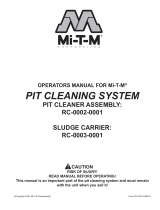
Introduction
Overview..............................................................................................................................................................................................5
Warranty.............................................................................................................................................................................................. 5
General instructions........................................................................................................................................................................ 5
Remove the unit..........................................................................................................................................................................5
Keep it clean..................................................................................................................................................................................5
Replace all O-rings and gaskets............................................................................................................................................. 5
Secure the unit.............................................................................................................................................................................6
Safety precautions............................................................................................................................................................................6
Unintended machine movement..........................................................................................................................................6
Flammable cleaning solvents.................................................................................................................................................6
Fluid under pressure..................................................................................................................................................................6
Personal safety.............................................................................................................................................................................6
Hazardous material.................................................................................................................................................................... 6
Symbols used in Danfoss literature............................................................................................................................................7
Design...................................................................................................................................................................................................7
The system circuit.............................................................................................................................................................................8
The basic closed circuit.............................................................................................................................................................8
Case drain and heat exchanger..............................................................................................................................................8
Motor schematic...............................................................................................................................................................................9
Fluid and filter maintenance
Fluid and filter recommendations........................................................................................................................................... 10
Hazardous material..................................................................................................................................................................10
Initial startup procedures
General ..............................................................................................................................................................................................11
Start-up procedure........................................................................................................................................................................11
Pressure measurements
Required tools.................................................................................................................................................................................13
Port and gauge installation........................................................................................................................................................13
Troubleshooting
Overview........................................................................................................................................................................................... 14
Safety precautions.........................................................................................................................................................................14
System operating hot...................................................................................................................................................................14
System will not operate in one direction.............................................................................................................................. 15
System will not operate in either direction.......................................................................................................................... 15
System response is sluggish...................................................................................................................................................... 15
Neutral difficult or impossible to find.....................................................................................................................................16
System noise or vibration........................................................................................................................................................... 16
Adjustments
Standard procedures, inspections, and adjustments....................................................................................................... 17
Warranty............................................................................................................................................................................................17
Motor adjustment..........................................................................................................................................................................17
Displacement limiter adjustment............................................................................................................................................ 17
Displacement limiter adjustment data.................................................................................................................................. 18
Minor repair
Standard procedures, removing the motor......................................................................................................................... 19
Removal........................................................................................................................................................................................19
Inspection....................................................................................................................................................................................19
Reassembly.................................................................................................................................................................................19
Shaft seal, ball bearing and shaft replacement...................................................................................................................19
Removal........................................................................................................................................................................................19
Inspection....................................................................................................................................................................................20
Reassembly.................................................................................................................................................................................20
Loop Flushing spool......................................................................................................................................................................21
Removal........................................................................................................................................................................................21
Inspection....................................................................................................................................................................................21
Service Manual
Series 40 M46 Variable Motor
Contents
11026745 • Rev BA • August 2014 3






















